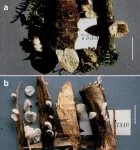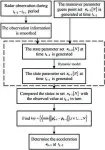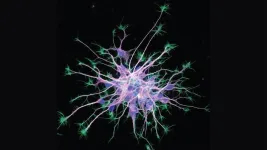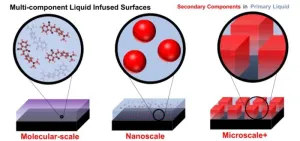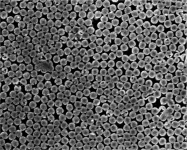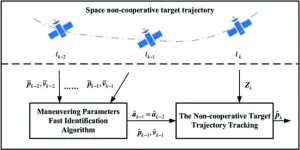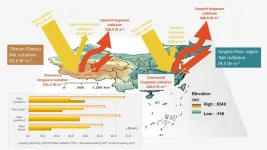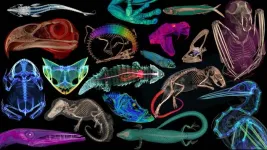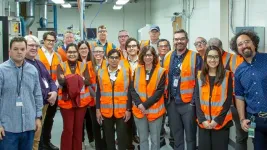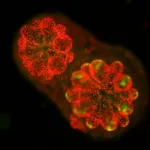A new genus of fungi on grasses
2024-03-06
(Press-News.org)
While ecologically important, small mushrooms on monocots (grasses and sedges) are rarely studied and a lack of information about their habitat and DNA sequences creates difficulties in determining their presence or absence in ecological studies and their genetic relationships to other mushroom taxa.
This study led by Drs. Karen W. Hughes and Ronald H. Petersen (University of Tennessee, Knoxville, TN, USA) examined a mushroom species, Campanella subdendrophora, (also known as Tetrapyrgos subdendrophora), which fruits on grasses in the US Pacific Northwest.
The researchers evaluated its phylogenetic position concerning both Campanella and Tetrapyrgos and determined that a new genus, Metacampanella was needed for this taxon (e.g., Metacampanella subdendrophora). Further, they identified other taxa that belonged to this group including taxa from Costa Rica and New Zealand, and named and described them where feasible. Metacampanella also includes an unknown taxon from the central US prairie grassland. In this latter case, the sequences were isolated from Prairie Dog dung (Rodents that eat root and shoot vegetation) and are presumably grass endophytes. (Herrera J. et al. 2011. Microb. Ecol. 61(2), 239–244). An endophyte of Elymus mollis (dune grass), was also identified as belonging to Metacampanella, (Metacampanella sinecystidia).
“To date, several Metacampanella appear to be associated with grasses. Future environmental studies may identify other members of this new genus.” Dr. Karen W. Hughes said.
See the article: Metacampanella gen. nov.: The Campanella dendrophora complex
END
ELSE PRESS RELEASES FROM THIS DATE:
2024-03-06
SEATTLE, WASH.—March 6, 2024—The Allen Institute has officially become the newest member of the Weill Neurohub, a collaborative research network advancing treatments for neurological diseases.
Founded in 2003 by philanthropist Paul G. Allen, the Allen Institute focuses on big questions in biology through a team-based, open science approach, and currently has moonshot projects in neuroscience, cell biology, and immunology institutes.
The new partnership will integrate the Allen Institute’s expertise ...
2024-03-06
Surface coatings have long been essential in various industries, offering protection and functionality. In recent years, liquid-infused surfaces (LIS) have emerged as a groundbreaking technology, revolutionizing how we approach surface coatings. In a review article recently published in Industrial Chemistry & Materials on Feb. 23, 2024, authors Zachary Applebee and Dr. Caitlin Howell explore a novel approach in surface technology that could significantly impact various industries, including healthcare and environmental conservation. A new frontier is emerging: multi-component ...
2024-03-06
Evaporation is a natural process so ubiquitous that most of us take it for granted. In fact, roughly half of the solar energy that reaches the earth drives evaporative processes. Since 2017, researchers have been working to harness the energy potential of evaporation via the hydrovoltaic (HV) effect, which allows electricity to be harvested when fluid is passed over the charged surface of a nanoscale device. Evaporation establishes a continuous flow within nanochannels inside these devices, which act as passive pumping mechanisms. This effect is also seen in the microcapillaries of plants, where ...
2024-03-06
Firstly, the authors briefly describe two models for tracking the maneuvering trajectories of non-cooperative space targets: the relative dynamics model and the indirect measurement model. In the relative dynamics model, tracking the maneuvering trajectory of the target is modeled as a problem of tracking the target's position over short discrete time intervals. On the other hand, the indirect measurement model transforms radar-derived values directly into measurements in the Local Vertical Local Horizontal (LVLH) coordinate system.
Next, the authors address the tracking problem of targets ...
2024-03-06
Land–atmosphere interactions play a crucial role in shaping Earth’s climate system, profoundly influencing weather patterns, climate variables, and ecological processes. Despite being located at similar latitude, the Tibetan Plateau (TP) and Yangtze River region (YRR) represent two distinct climate zones, garnering significant attention in this field. The former, situated in western China at an altitude exceeding 4000 m, is characterized by an arid climate, whereas the latter, located in the eastern Chinese plain, experiences a humid climate. Although both the TP and YRR have ...
2024-03-06
Spinal muscular atrophy, or SMA, is the leading genetic cause of infant death. Less than a decade ago, Cold Spring Harbor Laboratory (CSHL) Professor Adrian Krainer showed this brutal disease can be treated by tweaking a process called RNA splicing. This breakthrough resulted in Spinraza, the first effective treatment for SMA. It also opened a new frontier in drug development. Now, CSHL research could push RNA-splicing drugs even further. CSHL Associate Professor Justin Kinney, Krainer, and postdoc Yuma Ishigami have ...
2024-03-06
Read the online version (Available 8:00 a.m. ET, March 6, 2024)
Watch the video (Embargoed. Do not distribute before 8:00 a.m. ET, March 6, 2024)
Natural history museums have entered a new stage of scientific discovery and accessibility with the completion of openVertebrate (oVert), a five-year collaborative project among 18 institutions to create 3D reconstructions of vertebrate specimens and make them freely available online.
Researchers published a summary of the project in the journal BioScience in which they review the specimens that have been scanned to date and offer a glimpse of how the data might be used to ask new questions ...
2024-03-06
More than 120 people gathered for the 2024 Innovation Network for Fusion Energy (INFUSE) Workshop at the U.S. Department of Energy’s (DOE) Princeton Plasma Physics Laboratory (PPPL) from Feb. 27-28.
The event, which was sponsored by the DOE’s Office of Fusion Energy Sciences (FES), is a part of the INFUSE awards program that funds laboratories or universities so they can partner with private sector companies working on the science and technology ...
2024-03-06
The polysaccharide β-1,2-glucan consists of repeating units of glucose linked together by β-1,2-glycosidic bonds. Cyclic β-1,2-glucans (CβGs) occur in different bacterial species and have a role in bacterial infections and symbiotic relationships. CβG biosynthesis is catalyzed by cyclic β-1,2-glucan synthase (CGS), an enzyme that catalyzes the cyclization (closed ring formation) of linear β-1,2-glucan (LβG).
Since the method for large-scale enzymatic synthesis of linear β-1,2-glucan has already been established, combining it with this enzyme is technically feasible for efficient ...
2024-03-06
Scientists have discovered the gene that enables marine algae to make a unique type of chlorophyll. They successfully implanted this gene in a land plant, paving the way for better crop yields on less land.
Finding the gene solves a long-standing mystery amongst scientists about the molecular pathways that allow the algae to manufacture this chlorophyll and survive.
“Marine algae produce half of all the oxygen we breathe, even more than plants on land. And they feed huge food webs, fish that get eaten by mammals and humans,” said UC Riverside ...
LAST 30 PRESS RELEASES:
[Press-News.org] A new genus of fungi on grasses
